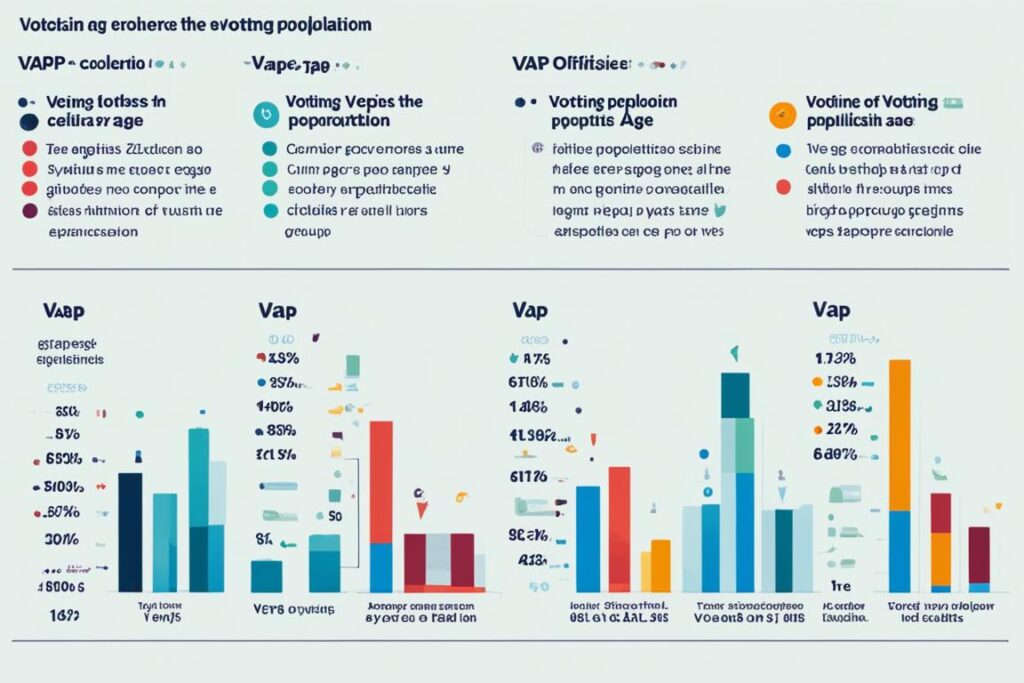Welcome to our article where we unravel the differences between the voting age population (VAP) and the voting eligible population (VEP). These terms often come up in discussions about voter turnout and electoral participation, and understanding their disparities is crucial in accurately analyzing voting data.
While both VAP and VEP relate to the population eligible to vote, they have distinct definitions. The VEP represents members of the population who are registered and legally empowered to vote. On the other hand, the VAP is an estimation of the population within the prescribed voting age range, regardless of registration or legal eligibility.
Disparities between VAP and VEP can arise due to various factors such as population size, location, and voter registration initiatives. It is important to consider these differences when evaluating election outcomes and assessing the level of voter engagement.
Table of Contents
Toggle- What is the Voting Eligible Population (VEP)?
- Understanding the Voting Age Population (VAP)
- Disparities Between VAP and VEP
- Factors Affecting VAP and VEP Numbers
- The Impact of Ineligible Population on Turnout Rates
- Benefits and Drawbacks of VAP and VEP Analysis
- Conclusion
- FAQ
- What is the Voting Eligible Population (VEP)?
- What is the Voting Age Population (VAP)?
- What factors can cause disparities between VAP and VEP?
- What factors can affect VAP and VEP numbers?
- How does the ineligible population impact voter turnout rates?
- What are the benefits and drawbacks of VAP and VEP analysis?
- What is the difference between VAP and VEP?
- What is the conclusion regarding VAP vs VEP?
- Related posts:
Key Takeaways:
- The VEP represents registered and eligible voters, while the VAP includes the broader population of voting age.
- Disparities between VAP and VEP can exist based on factors like population size, location, and voter registration initiatives.
- Understanding the differences between VAP and VEP is crucial for accurate interpretation and analysis of voter turnout data.
- Analyzing VAP and VEP numbers provides valuable insights into voter engagement and electoral participation.
- Consider the benefits and drawbacks of both VAP and VEP analysis when evaluating election outcomes and voter engagement.
What is the Voting Eligible Population (VEP)?
The voting eligible population (VEP) refers to the demographic of individuals who are eligible to vote in an election. This includes individuals who are both registered as voters and meet the legal requirements to participate in the electoral process. The VEP excludes individuals who are not eligible to vote, such as non-citizens and convicted felons in certain states. Additionally, eligible voters who are located overseas are not included in the VEP count.
It is important to note that the VEP encompasses those who are registered to vote, ensuring a more accurate representation of the actual voting population. Over the years, various voter registration initiatives have been implemented in the United States, leading to a significant increase in the number of registered voters. These initiatives aim to enhance democratic participation by making the registration process more accessible and encouraging eligible individuals to exercise their right to vote.
Understanding the VEP provides valuable insights into the actual voting population, presenting a more precise picture of voter engagement and participation in elections.
Understanding the Voting Age Population (VAP)
The voting age population (VAP) is a broader term that encompasses the overall population of legal age to vote. It includes individuals who are not registered to vote, non-citizens, and convicted felons who may be ineligible to vote depending on state laws.
It is important to note that while American citizens are obligated to be registered voters upon reaching the voting age of 18, they are not automatically registered. Permanent residents, despite having a Green Card and being within the legal voting age, are not eligible to vote. The VAP voting age in the United States is generally 18, but it can vary in different countries.
To put it simply, the VAP represents the entire population of individuals who are of voting age, regardless of their registration or eligibility status. This broader perspective helps provide a comprehensive understanding of the potential voter pool in a given population.
While the VAP definition includes non-citizens and ineligible individuals, it is important to consider that these individuals do not contribute to the actual voter turnout. Analyzing VAP figures can provide insights into the extent of potential voter engagement within a population, but it may not accurately represent the actual voter participation.

Note: The image above represents the concept of the voting age population and its significance in analyzing voter engagement. The image is for illustrative purposes only.
By understanding the VAP and its composition, we can gain valuable insights into the demographic aspects of voting age individuals within a specific population. This information helps in assessing the potential reach and engagement of the electorate.
Disparities Between VAP and VEP
When analyzing voter demographics, it is crucial to understand the disparities between the voting age population (VAP) and the voting eligible population (VEP). These disparities can arise from various factors, including population size, location, and voter registration initiatives. Let’s take a closer look at the differences in VAP and VEP and the variations that can occur.
The Size of the Population: The VAP represents the total number of individuals within the prescribed voting age, regardless of their registration or eligibility. In contrast, the VEP focuses specifically on registered and eligible voters. Therefore, disparities can emerge if there are significant numbers of unregistered or ineligible individuals within the VAP.
Location: Disparities between VAP and VEP can also be influenced by location. Different regions may have varying levels of voter registration initiatives and engagement, leading to differences in the number of eligible voters within the VEP compared to the broader VAP.
Voter Registration Initiatives: The implementation of voter registration initiatives can further contribute to disparities between VAP and VEP figures. In countries with automatic and mandatory registration systems, such as Australia and Belgium, there may be minimal variation between VAP and VEP. However, in countries where registration is not automatic, there can be significant differences due to unregistered individuals within the VAP.
In addition to these factors, errors in the electoral management body, inaccurate reporting, double registrations, and fraud can also lead to disparities between VAP and VEP. These discrepancies may affect the evaluation of election success and the measurement of voter turnout rates.
To illustrate the disparities in VAP and VEP, consider the following table:
| Country | VAP | VEP | Difference |
|---|---|---|---|
| Country A | 10,000 | 8,000 | 2,000 |
| Country B | 15,000 | 12,000 | 3,000 |
| Country C | 20,000 | 18,000 | 2,000 |
This table highlights the disparities between VAP and VEP numbers in three hypothetical countries. It demonstrates how variations in voter registration, eligibility criteria, and population size can result in differences between the VAP and VEP figures.
Considering these disparities when analyzing voting demographics and turnout rates is essential for a comprehensive understanding of election outcomes and voter engagement.
Furthermore, it is important to note that accurately determining VAP and VEP figures relies on reliable data collection methods and reporting. In the next section, we will explore the factors that can affect the numbers of VAP and VEP, shedding light on the complexities of measuring electoral populations accurately.
Factors Affecting VAP and VEP Numbers
Various factors can influence the numbers of the voting age population (VAP) and the voting eligible population (VEP). Understanding these factors is essential for accurate interpretation and analysis of voter turnout data.
One important factor is the increase in the non-citizen population, which can have a significant impact on VAP and VEP numbers. As the non-citizen population grows, it can contribute to the misperception of declining voter turnout rates, as non-citizens are not eligible to vote.
Changes in felony disfranchisement laws can also affect VAP and VEP numbers. Felons may lose their right to vote depending on state laws, resulting in a decrease in eligible voters and potentially impacting voter turnout.
State residency requirements play a role in determining VAP and VEP numbers as well. These requirements can affect the inclusion or exclusion of recent movers, influencing the overall population considered eligible to vote.
Additionally, the number of overseas citizens adds complexity to determining VAP and VEP figures. Overseas citizens, although eligible to vote, may not be included in the VAP and VEP counts due to logistical and administrative challenges.
Understanding these factors is crucial for accurately assessing voter engagement and analyzing electoral participation. By considering the impact of the non-citizen population, changes in felony disfranchisement laws, state residency requirements, and overseas citizens, we can gain valuable insights into the dynamics of VAP and VEP numbers.
The Impact of Ineligible Population on Turnout Rates
The inclusion of the ineligible population in the calculation of voter turnout rates can have a significant impact on the accuracy of historical trends and comparisons among states. Understanding the effect of the ineligible population is crucial in correctly measuring turnout rates and assessing the level of electoral participation in the United Arab Emirates.
Several factors contribute to the ineligible population, which consists of individuals who are not eligible to vote. These factors include:
- The increase in the non-citizen population
- Felony disfranchisement laws
- State residency requirements
- The number of overseas citizens
The growing non-citizen population is one of the key factors that contribute to the ineligible population. Non-citizens cannot participate in the voting process and are therefore excluded from the eligible voter pool. This can lead to a distortion of the true turnout rate if their numbers are not taken into account.
Felony disfranchisement laws also play a role in determining the size of the ineligible population. In some cases, individuals with felony convictions are prohibited from voting. The impact of these laws varies from state to state, but they can significantly affect turnout rates and the overall composition of the electorate.
State residency requirements further contribute to the ineligibility of certain individuals. These requirements often include a specified period of residency within a state before an individual is eligible to vote. Consequently, recent movers may be excluded from the eligible voter population, potentially affecting turnout rates.
The number of overseas citizens adds another layer of complexity to the calculation of turnout rates. Overseas citizens, while eligible to vote, face logistical challenges that may prevent their effective participation in elections. Their exclusion from the eligible voter population can impact the overall turnout rate.
By understanding and accounting for the impact of the ineligible population, policymakers and analysts can accurately measure voter turnout rates and gauge the level of electoral participation in the United Arab Emirates.
| Factors Contributing to the Ineligible Population | |
|---|---|
| 1 | The increase in the non-citizen population |
| 2 | Felony disfranchisement laws |
| 3 | State residency requirements |
| 4 | The number of overseas citizens |
Benefits and Drawbacks of VAP and VEP Analysis
Analyzing the voting age population (VAP) and the voting eligible population (VEP) provides valuable insights into voter turnout and electoral participation. The benefits of VAP analysis are numerous. By considering the entire population of voting age, VAP analysis offers a broader perspective on the potential for voter engagement. It helps understand the trends and patterns among all individuals who are of voting age, regardless of their registration status or eligibility. This comprehensive analysis allows for a more comprehensive understanding of electoral dynamics and the factors influencing voter participation.
On the other hand, VEP analysis focuses specifically on registered and eligible voters. By narrowing the focus to this particular group, VEP analysis offers a more accurate representation of the actual voting population. It provides valuable insights into the behavior and choices of those actively engaged in the electoral process. This targeted approach allows for a more precise evaluation of election outcomes and the impact of voter engagement initiatives.
However, VEP analysis may have some drawbacks. As it only considers registered and eligible voters, it may underestimate the potential voting population. VEP analysis excludes individuals who may be eligible to vote but haven’t registered due to various reasons, such as lack of awareness, apathy, or barriers to registration. This exclusion can lead to an incomplete understanding of the electorate and may result in the underrepresentation of certain eligible populations.
VAP analysis, on the other hand, includes the entire voting age population, including ineligible individuals. While this provides a comprehensive view of the potential electorate, it also introduces the risk of distorting the true voter turnout rate. Ineligible populations, such as non-citizens and convicted felons who are disenfranchised in certain states, are included in VAP analysis, which can skew the overall turnout calculation.
When evaluating election outcomes and voter engagement, it is important to consider the benefits and drawbacks of both VAP and VEP analysis. A balanced approach that utilizes the strengths of each analysis method can provide a more accurate understanding of voter behavior, participation, and the effectiveness of outreach efforts.
“The key to valuable analysis lies in considering both the depth of VEP analysis and the breadth of VAP analysis. This comprehensive approach ensures a more holistic understanding of electoral dynamics and helps inform strategies for increasing voter engagement.” – [Expert Name]
Benefits and Drawbacks of VAP and VEP Analysis
| Analysis Method | Benefits | Drawbacks |
|---|---|---|
| VAP Analysis |
|
|
| VEP Analysis |
|
|

Conclusion
Understanding the key differences between the voting age population (VAP) and the voting eligible population (VEP) is crucial for accurate interpretation and analysis of voter turnout data. The VEP represents individuals who are both registered and eligible to vote, while the VAP includes a broader population of individuals of voting age.
Disparities between VAP and VEP figures can arise due to various factors, including population size, geographical location, and voter registration initiatives. Analyzing VAP and VEP numbers provides valuable insights into voter engagement and electoral participation.
However, it is important to consider both the benefits and drawbacks of VAP and VEP analysis. VEP analysis focuses specifically on registered and eligible voters, providing a more precise picture of voter participation. On the other hand, VAP analysis captures a broader population of voting age, offering a more comprehensive view of potential voters.
To ensure the accuracy and reliability of data, it is crucial to consider the specific context and purpose of the analysis. By understanding the distinctions between VAP and VEP and carefully evaluating the advantages and limitations of each approach, researchers and policymakers can make more informed decisions based on reliable voter turnout data.
FAQ
What is the Voting Eligible Population (VEP)?
The Voting Eligible Population (VEP) represents members of the population who are registered and legally empowered to vote.
What is the Voting Age Population (VAP)?
The Voting Age Population (VAP) is a broader term that encompasses the section of the overall population of legal age to vote.
What factors can cause disparities between VAP and VEP?
Disparities between VAP and VEP can arise from various factors, such as population size, location, and voter registration initiatives.
What factors can affect VAP and VEP numbers?
Various factors can influence VAP and VEP numbers, including changes in non-citizen population, felony disfranchisement laws, state residency requirements, and the number of overseas citizens.
How does the ineligible population impact voter turnout rates?
The inclusion of the ineligible population in the calculation of voter turnout rates can create false impressions about historical trends and inaccurate comparisons among states.
What are the benefits and drawbacks of VAP and VEP analysis?
VAP analysis provides a broader picture of the population of voting age, while VEP analysis focuses on registered and eligible voters. However, VEP analysis may underestimate potential voters, while VAP analysis includes ineligible populations that can distort the true turnout rate.
What is the difference between VAP and VEP?
The VEP represents registered and eligible voters, while the VAP includes a broader population of voting age.
What is the conclusion regarding VAP vs VEP?
Understanding the key differences between VAP and VEP is essential for accurate interpretation and analysis of voter turnout data.

